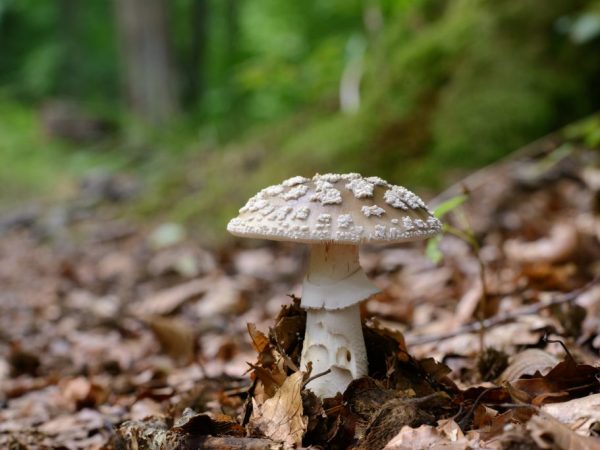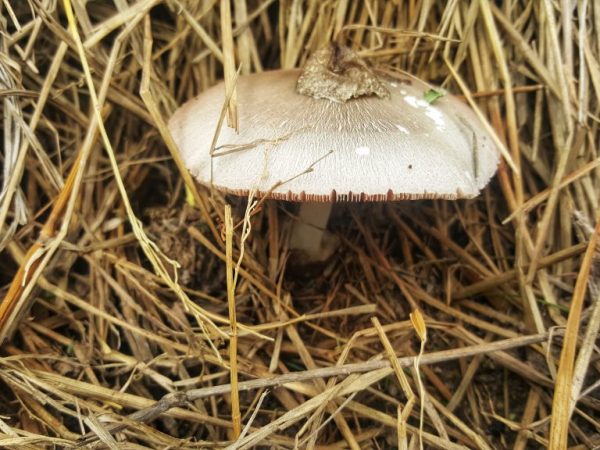Description of mushroom umbrella
Umbrella mushrooms have occupied almost all continents, except for Antarctica, which means that such a name as cosmopolitans suits them. By the way of feeding, they are saprotrophs. They grow in free clearings in the forest. Edible species can be grown in the open field, and you can also use a greenhouse for these purposes.

Description of mushroom umbrella
Appearance
The umbrella mushroom is a typical Basidiomycot. It belongs to the class Agaricomycetes, is included in the Agaricaceae order, the Champignon family. Most of the umbrellas belong to the Macrolepiota genus.
Umbrella mushrooms are edible (category 2-4) and poisonous. To correctly distinguish poisonous twins, you should read the description of the main species. The fruiting body has a cap-toed structure from small to large in size.
The mushrooms got their name from their elongated legs. At its end there is a domed hat that looks like an umbrella cane when opened.
Hat
The cap reaches 10-40 cm in diameter, depending on the type of mushroom. The lower part - the leg can reach a length of 38-45 cm. The hat is characterized by a whitish color with splashes. These are the scales that the umbrella mushroom can show when ripe. The shape of the cap changes from ovoid and hemispherical to almost flat as the fruiting body develops and resembles a wide umbrella.
Regardless of the type, the caps of the fruit bodies have a central elevation, similar to a small mound.
The hymenophore is represented by often located plates, weakly attached to the pedicle. As the fungus grows, they darken, turn gray. Spores are white or creamy.
Leg
The lower part of the fruiting body is cylindrical, sometimes straight, and sometimes inclined. Inside it is hollow, stained when cut. There is a small tuber-like seal at the base.
The leg always has a narrow or wide ring located close to the head. It is film-like in structure. It can be easily moved. The color of the ring is white or brown. It happens in two colors: white at the top and dark at the bottom. For your information. The ring, or "skirt" of mushrooms is often called the remainder of the private veil that covers the hymenophore with ripening spores.
Edible species
Young fresh fruiting bodies are selected. Their benefit is that the nutrients of the mushroom are completely absorbed, even if it is dried.
They use the tops (caps) of umbrellas: they have a soft, friable pulp with a pleasant aroma. Legs do not eat. Old, large fruit bodies are sifted out due to the rather high rigidity of the pulp.
Before use, the mushrooms are carefully examined for the presence of parasites. Specially for them are representatives of the variegated umbrella species. For disinfection, mushrooms are soaked in salted water for 20 minutes. After that, they are recommended to be cooked, dried or frozen.
A common cooking method is to fry in batter. Hats retain their shape, taste, do not disintegrate. Some mushrooms are used as a delicacy in Chinese cuisine.Healthy salads and soups are made with them. Fruit bodies are often eaten baked with vegetables or meat.
The calorie content of umbrellas is low. They are used in dietary nutrition.
Fruiting bodies should be frozen using sterile containers. Mushrooms can withstand storage for no more than 3-4 months. Freezing allows you to preserve all the useful properties.
Umbrella white
A common soil saprotroph is a white umbrella mushroom, or field mushroom. Another white umbrella is called a "flower". He prefers steppes, open meadows of mixed forest.
Distribution area:
- European part of Eurasia;
- Iran;
- Turkey;
- Siberia;
- Far East;
- American continents;
- some parts of Cuba, Sri Lanka.
The mushroom is found in a group or one at a time. The collection of fruit bodies is carried out from June to the 2nd half of September.

Not all umbrellas are edible
The fruit body of the white umbrella looks like a poisonous smelly fly agaric. It is distinguished by the presence of mucus on the cap. There is also a scaly pattern.
Amanita's leg is distinguished by a characteristic bag-shaped blanket. It is sometimes buried in the ground.
Hat
Fruiting bodies are distinguished by a small thickened fleshy cap, which reaches 10-12 cm in diameter.
Skin color is beige-whitish. The edges of the cap are strewn with voluminous white fibers. A tubercle of dark brown color clearly stands out in the middle. It is rough to the touch. Inside, the pulp is colorless.
The plates of young fruit bodies are bright white. Older specimens have different shades of brown.
Leg
Reaches a height of 7-12 cm and a thickness of 0.5-1 cm. It is characterized by the presence of a slight thickening at the base. The cut is white-gray.
The stem is smooth, yellowish from the ring down. Above is white or beige. Darkens to brown when touched.
Umbrella graceful
Representatives of the species are found in meadows and fields in the Transcaucasus, Primorsky Territory, USA, Canada, and some African countries. They prefer sandy soil.
The species is common in many countries of the European part of the continent, except for:
- Norway;
- The Balkans;
- The Republic of Belarus.
The fruiting body does not grow large. The hat is bell-shaped, light yellow. The leg grows up to 13-15 cm. Its diameter is up to 2.2 cm. The leg changes color depending on the age of the fungus: in young it is light, in mature it darkens. Its surface is covered with yellow or brown flakes. The pulp of the mushroom has a fresh smell and good taste.
Motley umbrella
The colorful umbrella is found on the territory of the countries of the American continents, Eurasia. He adapted well to the cold climate.
Mushroom umbrella variegated - the largest of the edible. Its cap reaches 42 cm in width with a relative thinness (2-3 cm) of the layer of pulp. The skin covering the surface of the cap is colored in a bright brownish-red hue. The motley umbrella has frequent, well-detachable scales on it.
The stem of the young fruiting body is completely brown. The old one becomes brown. Brown flakes appear, which in the pattern resemble a "snake print".
A wide "skirt" can be seen immediately under the hat. It darkens as it matures. Volvo is missing.
Irina Selyutina (Biologist):
Due to its good taste - light, fleshy pulp with a pleasant nutty taste and a weak aroma, the motley umbrella, after removing the scales from the surface of the cap, can be used for any kind of cooking, even raw. Only hats are used for food, hard legs are discarded. This type is especially appreciated by French gourmets, who believe that it should be fried in oil with herbs. In Italy, a "personal name" - drumsticks (mazza di tamburo) - was assigned to the colorful umbrella. The only drawback that both gourmets and culinary experts recognize for him is a strong frying.
The variegated umbrella is a typical saprotroph that simply loves to settle on open sandy soils. Mycologists note that this species can grow in several ways:
- singly;
- rare families;
- rows;
- witch circles.
Conrad's Umbrella

Kornada mushrooms are popular for harvesting for the winter.
Konrad's umbrella prefers a forested area. Grows in Europe and Asia.
The hat becomes thinner towards the edges. Its shape is spherical, rounded, bell-shaped, like an umbrella. The surface of the cap is off-white. The skin covering the cap does not reach its edges. There is a black tubercle in the middle.
The leg grows up to 12-15 cm, has a diameter of 0.7-1.2 cm. Its color is brown. The stem usually thickens towards the base.
The plates are distinguished by a white, creamy shade. They are free, widely spaced.
A common way of cooking is harvesting for the winter. For this:
- the cap is cut off from the leg;
- it is cleaned, washed well;
- boil for 10-15 minutes;
- prepared according to any of the recipes.
Inedible species
Poisonous umbrella false mushrooms contain toxic substances that are not fully understood. The inedible poisonous umbrella mushroom has a hallucinogenic effect due to the presence of toxins in its pulp. Poisoning occurs due to the content of the following highly toxic substances:
- fallina;
- phalloidin;
- amishin.
Fallin can be rendered harmless by heat treatment. Other toxic substances remain unchanged, and therefore can lead to irreversible damage and death without timely assistance.
Crested lepiota
Representatives of the species grow in temperate forests in the north. The culture prefers the European part of the continent.
The cap is small, up to 5 cm in diameter. The shape is the same as that of a girl's umbrella. Differs in the external features of the tubercle in the middle. He is small, bright red in the lepiota. The girl's umbrella has a dark mound. The scales on the cap are sparse, pointed. They are yellow or ocher.
The ring on the leg is pinkish, thin, movable. When cut, the pulp fibers are clearly visible. The smell is pungent, unpleasant.
Lepiota rough
The species is also called the sharp-scaled umbrella. It is found in Europe, Mexico, northern Africa.
The cap is fleshy, fleecy, ovoid. It grows up to 14-15 cm in diameter. Has characteristic rust-colored scales.
These mushroom umbrellas have pale yellow legs with horizontal wavy brown stripes barely visible to the eye.
The wide ring has noticeable brown blotches on its surface. The taste of the pulp is bitter, unpleasant. The smell is pungent.
Chlorophyllum lead-slag
The species is called a false umbrella. It is found in Australia, Europe, USA, North Africa. The fruit body resembles a variegated umbrella in appearance. The poisonous twin is distinguished by the following features:
- pink rare flakes on the cap;
- large diameter of the cap - up to 35 cm;
- the flesh on the cut turns orange or brown;
- lack of smell and taste;
- green-gray plates in mature mushrooms.
Chlorophyllum dark brown
The forest species is widespread in Hungary, USA, Croatia, Slovenia. Prefers areas with a humid swampy climate.
Irina Selyutina (Biologist):
Chlorophyllum is dark brown, or, as it is also called, chlorophyllum brown, is a poisonous mushroom that looks like an umbrella mushroom. It is the same variegated, on the surface of the cap there are scales and a ring on the leg. The main difference between chlorophyllum and an umbrella is its "stockiness" (the leg is small in length, plus it is rather thick and dense). Some sources claim that this species has hallucinogenic properties, but its chemical composition has not yet been fully understood. It is known that in some people, eating it led to serious allergic and other reactions.
This species is not found in Russia.
The brown cap of the inedible umbrella mushroom reaches a diameter of 13-14 cm. The stem changes color from beige to brown-brown. At the base of the leg, there is a characteristic tuberous outgrowth that grows up to 5-6 cm in diameter.
The flesh at the fruiting body is white, but its cut in air changes color to orange-red.
Conclusion
For a clear distinction between edible and dangerous mushrooms, study the relevant information. Only well-known fruiting bodies are harvested. For any - even the slightest doubt, the mushroom is not picked.
It is not recommended to collect the fruiting bodies of mushrooms in a polluted, ecologically unfavorable area. They are capable of accumulating heavy metals, pesticides, and radionuclides. It is better not to touch poisonous mushrooms with your hands, bypass them.



